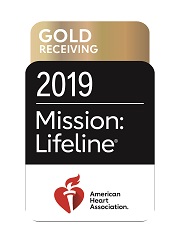When an emergency services dispatcher receives a call about a potential heart attack victim, physicians and nurses at Hartford Hospital must be prepared to provide the best care possible when the patient is brought through the emergency room door.
Specialized treatment is critical when it comes to an ST-segment elevation myocardial infarction, also known as a STEMI heart attack, the most severe type of heart attack caused by blockage of blood flow to the heart. A STEMI means the artery is 100 percent blocked. These heart attacks require the timeliest treatment to ensure the best possible outcome.
 For the second year in a row, the American Heart Association has recognized Hartford Hospital’s efforts to improve care for STEMI heart attack patients, recently honoring its work in 2018 with the Mission: Lifeline Gold Receiving Quality Achievement Award. Last year, Hartford Hospital’s response times placed it among the top 10 percent of hospitals in the nation — exceeding the American Heart Association standard.
For the second year in a row, the American Heart Association has recognized Hartford Hospital’s efforts to improve care for STEMI heart attack patients, recently honoring its work in 2018 with the Mission: Lifeline Gold Receiving Quality Achievement Award. Last year, Hartford Hospital’s response times placed it among the top 10 percent of hospitals in the nation — exceeding the American Heart Association standard.
“We’re proud of this recognition because it reflects our perpetual drive toward improvement, to do everything we can to ensure the best possible outcome for people whose lives have been placed in our hands,” said Dr. Raymond McKay, Co-Director of the Hartford HealthCare Heart & Vascular Institute’s Structural Heart Disease Program.
According to the American Heart Association, every year more than 250,000 people experience a STEMI. Last year, Hartford Hospital cared for more than 200 STEMI patients.
Because delays in treating a heart attack increase cardiac muscle damage, time is muscle.
Related: Heart & Vascular Institute Earns Top Cardiac Surgery Ratings in North America
The Mission: Lifeline program provides response and treatment guidelines that unify efforts of first responders and staff in hospital emergency departments and cardiac catheterization labs. Central to that is the association’s recommended 90-minutes-or-less “door to balloon” time (D2B) for STEMI heart attacks — a way to measure how much time has passed between when the patient arrives in the emergency department and when a balloon is inserted into the artery to treat the blockage.
In 2017, Hartford Hospital’s D2B time was 55 minutes. One year later in 2018, that time was 49 minutes, reducing D2B by 6 additional minutes. Those times exceed not only the 90-minutes-or-less D2B standard, but also a 90-minutes or less “first medical contact to balloon” (FMCTB) standard that’s gaining traction nationwide.
“We can’t achieve these types of improvements without thorough communication among all the members of our team, and at Hartford Hospital, our teams relentlessly pursue strategies to eliminate barriers to getting patients into cardiac care as quickly as possible,” said Dr. Francis Kiernan, Director of the Cardiac Catheterization Lab and Co-Director of the Structural Heart Program.
Teams at Hartford Hospital consistently review each STEMI case to identify opportunities to improve the timeliness of care. For example, how quickly was the patient’s electrocardiogram transmitted to the hospital before the patient’s arrival? This information is shared among the three teams responsible for immediate STEMI care — the Cardiac Catheterization Lab, the Emergency Department and Emergency Medical Services (EMS) providers.
The collaboration between those three teams exemplifies Hartford HealthCare’s overall approach to cardiovascular disease, prevention and research, making it a national leader in the field.
Click here to learn more about heart attacks and their treatment at the Hartford HealthCare Heart & Vascular Institute.


